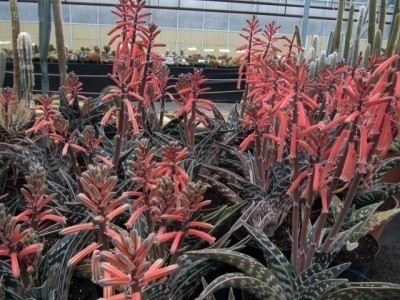






Spiky leaved aloe plants are a spectacular addition to the warm season landscape and provide interest to container gardens. Tiger aloe plants (Aloe variegata), with their streaked leaves and salmon pink flowers, will amaze the succulent lover. They are a unique cultivar also known as Partridge Breast aloe. Learn how to care for a tiger aloe and enjoy the leaves and plume-like flowers of this attractive plant.
Tiger aloe will amaze and delight the gardener with a penchant for succulents. This variety has the classic sword-shaped thick leaves and healing sap boasted by more common varieties.
Variegated tiger aloe blooms from July through September in its native habits of Namibia and South Africa. Home grown plants will produce similarly with good care and bright sunlight.
The arrangement of the leaves provides an interesting tidbit of tiger aloe information. They are generally produced in three sets of six to eight leaves around a central rosette. The slightly serrated edges and thick waxy coated foliage sport mottled white and green patterns.
Tiger aloe plants may get 12 inches high and around 9 inches wide. The flowers are borne on a stiff slender stalk and may be pink, orange or a salmon pink. Leaves are 4 to 6 inches long and just a couple of inches wide. In their natural range, they are found in gritty soils where rainfall is infrequent. They can withstand periods of drought by storing moisture in their leaves and conserving it with a waxy cuticle over the foliage.
Tiger aloe has the same requirements as other succulent aloes. The plant is suited for warmer zones and may be taken outside in summer in cooler areas. Don’t forget to bring it in when cold temperatures are approaching, as the plant is only hardy in USDA zones 9 to 11. The majority of gardeners will find it easier to grow the plant inside alone in a container or as part of a succulent display.
Water deeply but rarely and let the soil dry out between watering. The plant grows slowly but should be repotted every three years in a good mix of potting soil and sand or cactus mix. The biggest problem that occurs with aloe plants is overwatering, which can cause the plant to rot.
A fun thing about these plants is their ability to produce fully vegetative babies or offsets for propagation. Divide these away from the parent plant and place them in a container. They will root quickly and provide you with more of this amazing plant to populate your landscape or give away to an appreciative friend.
The easiest way to propagate the plant is by growing tiger aloe from the babies at its edges. They should pull away fairly easily or you can cut them cleanly from the parent.
Copyright © www.100flowers.win Botanic Garden All Rights Reserved